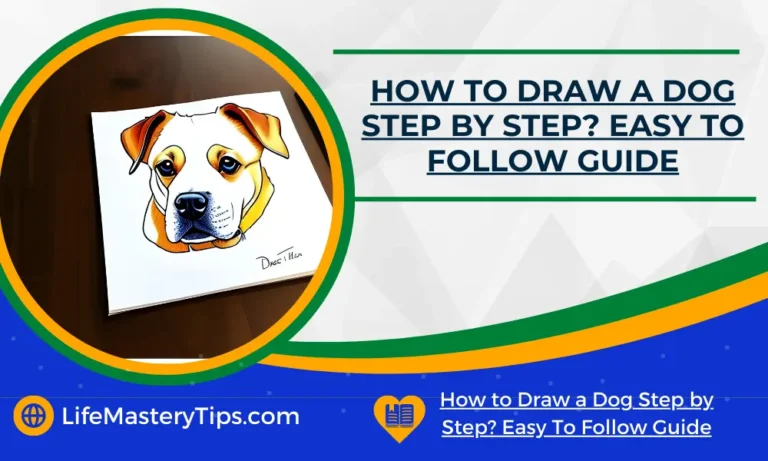Do you want to know how to Draw a Dog Step by Step? Drawing a dog can be a fun and rewarding experience, even if you’re a beginner. In this step-by-step guide, we’ll walk you through the process of drawing a dog from scratch. So grab your pencil, paper, and let’s get started!
Another Interesting Read: How To Care for a Bear Newfoundland Dog?
Drawing is a wonderful form of self-expression and creativity. Whether you’re an aspiring artist or simply want to try your hand at drawing, learning to draw a dog can be a rewarding experience. Dogs are beloved animals, and being able to capture their likeness on paper allows you to celebrate their beauty and charm. In this step-by-step guide, we will explore the process of drawing a dog in a simple and easy-to-follow manner.
Introduction: Why Learn to Draw a Dog?
Drawing a dog not only helps you develop your artistic skills but also allows you to create meaningful artwork that resonates with others. Dogs are one of the most popular subjects for drawings, and being able to depict them accurately can bring joy to both the artist and the viewers. Moreover, learning to draw a dog can serve as a foundation for drawing other animals as well, as many of the techniques used are transferable.
You can watch the video below:
Gathering the Right Materials
Before we begin drawing, it’s essential to gather the right materials. Here’s a list of the basic supplies you’ll need:
- Paper: Choose a good-quality drawing paper that suits your preferred medium.
- Pencils: Get a range of graphite pencils, including HB, 2B, 4B, and 6B for different shading effects.
- Eraser: Have a kneaded eraser or a vinyl eraser to correct mistakes and lighten pencil marks.
- Pencil Sharpener: Keep a sharpener handy to maintain a fine point on your pencils.
- Reference Images: Find high-quality images of dogs that inspire you and serve as a reference for proportions and details.
Now that we have our materials ready, let’s dive into the step-by-step process of drawing a dog.
Step 1: Sketching Basic Shapes
To start, we’ll create a rough outline of the dog using basic shapes. This helps us establish the proportions and overall structure. Let’s begin with the dog’s head.
Drawing the Dog’s Head
- Start by lightly sketching a circle on your paper. This will serve as the base for the head.
- Add two intersecting lines within the circle, dividing it into four equal sections. These guidelines will help with placing the facial features later.
Adding the Ears and Eyes
- From the top left section of the circle, draw a curved line that slopes slightly outward. Repeat on the right side to create the dog’s ears.
- Within the bottom sections of the circle, draw two almond-shaped eyes along the horizontal guideline. Leave a small space between them.
Creating the Nose and Mouth
- Below the eyes, draw a triangular shape for the nose. It should be centered and slightly wider than the eyes.
- Add a small curved line above the nose to represent the dog’s mouth.
Now that we have the basic head structure in place, let’s move on to refining the outline in Step 2.
Step 2: Refining the Outline
In this step, we’ll refine the dog’s outline, adding more details to bring it to life.
Shaping the Dog’s Face and Snout
- Use the basic head structure as a guide and start defining the dog’s face by adding curved lines around the circle. These lines should outline the cheeks and lower jaw.
- Connect the head to the snout by drawing a curved line from the bottom of the head to the mouth.
Adding Details to the Eyes and Ears
- Enhance the eyes by adding pupils within the almond shapes. Add small highlights to make them appear more realistic.
- Define the shape of the ears by adding curves and details, such as folds or tufts of fur.
Drawing the Dog’s Mouth and Tongue
- Refine the mouth by adding a curved line below the nose, indicating the upper lip.
- Draw a tongue by adding a curved shape within the mouth. Add some texture to suggest its surface.
With the outline refined, let’s move on to adding fur and texture in Step 3.
Step 3: Adding Fur and Texture
To make our drawing more realistic and expressive, we’ll focus on adding fur and texture to the dog’s face.
Defining the Dog’s Facial Features
- Use short, curved strokes to represent the fur around the dog’s eyes and ears. Vary the length and direction of the strokes to create a realistic texture.
- Add some shadows around the eyes, using darker pencil grades like 4B or 6B. This will enhance the depth and make the eyes stand out.
Creating the Fur Texture
- Gradually build up the fur texture by using light, feathery strokes. Follow the contours of the face and body to create a sense of volume.
- Pay attention to the direction of the fur and adjust your strokes accordingly. Use reference images to guide you in capturing the specific fur patterns of the dog breed you’re drawing.
Adding Shading and Highlights
- Create depth and dimension by adding shading to the areas of the face that are in shadow. Use darker pencil grades and build up the layers gradually.
- Add highlights to the areas where light hits the dog’s face, such as the forehead, nose, and cheeks. Leave some areas untouched to create contrast.
Now that we have detailed the face, let’s move on to drawing the body and legs in Step 4.
Step 4: Drawing the Body and Legs
In this step, we’ll focus on sketching the dog’s body and legs, ensuring they are proportionate to the head.
Sketching the Dog’s Neck and Chest
- Extend two curved lines downwards from the head to create the neck.
- From the base of the neck, draw a curved line that outlines the chest and belly of the dog.
Drawing the Forelegs and Hind Legs
- From the chest, extend two lines diagonally downward to create the forelegs. Add small ovals at the ends to represent the paws.
- Repeat the process to draw the hind legs, making them slightly longer than the forelegs. Include ovals for the paws as well.
Adding Paws and Details
- Refine the shape of the paws by adding more curves and defining the individual toes.
- Include small details like claws or pads on the paws to make them more realistic.
With the body and legs in place, we are almost done with our drawing. Let’s move on to the final step.
Step 5: Finalizing the Drawing
In this step, we’ll focus on refining the overall drawing, adding final touches, and erasing any unnecessary guidelines.
Refining the Body Shape
- Examine the proportions of the body and make any necessary adjustments.
- Use smooth, confident lines to outline the body, making it appear more solid and three-dimensional.
Adding Tail and Whiskers
- Extend a curved line from the back of the dog to represent the tail. Add some texture to indicate fur.
- Draw short, straight lines extending from the dog’s muzzle to depict the whiskers.
Erasing Guidelines and Adding Final Touches
- Carefully erase any remaining guidelines and excess pencil marks, especially around the face.
- Take a step back and assess your drawing. Make any final adjustments or additions to enhance the overall appearance.
Congratulations! You have successfully drawn a dog step by step. With practice and patience, your drawings will continue to improve. Remember to experiment with different breeds and poses to expand your skills.
Here is Another Video You can watch:
Conclusion
Drawing a dog can be a fun and rewarding experience, allowing you to showcase your creativity and artistic abilities. By following this easy-to-follow guide, you’ve learned the step-by-step process of drawing a dog from basic shapes to refined outlines and detailed features. Remember to practice regularly and have fun with your drawings. With time, you’ll develop your own style and techniques to create unique and captivating dog illustrations.
You Might Also Like:
French Bulldog and Chinese Crested Dog: Breeding and Health Guide




